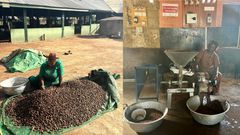For millions of people across West Africa—and increasingly, the globe—the ritual of applying shea butter is more than just a skincare routine. That creamy golden balm soothes everything from dry skin to sunburn, and many trust it to keep their skin supple and youthfully radiant. Yet, few realise the enormous dedication, manual skill, and cultural heritage that lie behind every jar of shea butter. At the heart of this age-old process are rural West African women, who not only uphold tradition but also support their families through their hard work in the shea industry.
Zakaria Adama Lacera leads Yumzaa Enterprises, a prominent shea processing business in Tamale, Ghana, but her story rings familiar for many Nigerian entrepreneurs in the shea belt stretching across the north. As she recounts, Yumzaa started humbly—with only three women working to transform shea nuts. Today, those modest beginnings have blossomed into an enterprise employing about 270 dedicated processors and a network of some 1,500 women who collect the wild nuts. This growth not only demonstrates the opportunities within the shea industry but also its pivotal role in transforming lives across West Africa.
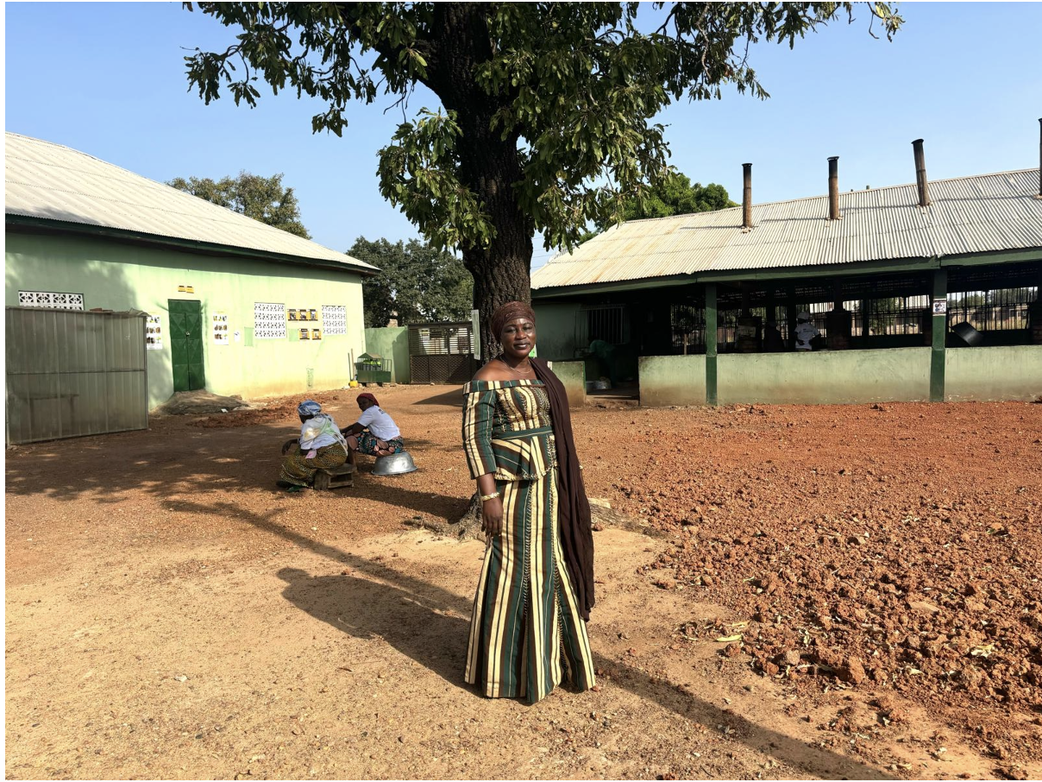
Zakaria Adama Lacera, the CEO of Yumzaa Enterprises. (Picture: Zoe Geissler)
“The shea industry supports the livelihoods of countless rural women in northern Ghana, and we’re proud to be part of this journey,” she shared during a tour of her bustling processing centre, according to a report by Pulse Ghana.
From Wild Tree to Local Livelihood: The Journey of Shea
Step 1: Picking the Nuts
The shea tree—a species native to West Africa’s savannas—thrives especially from northern Nigeria through Ghana, Burkina Faso, and beyond. In Nigeria, large swathes of the north are dotted with these resilient trees, providing economic lifelines for local women. However, patience is key: it can take up to three decades for a shea tree to produce enough fruit to be harvested at scale, according to agricultural experts at the Nigerian Institute for Oil Palm Research.
Unlike some tree products, shea pickers don’t climb or cut; rather, they carefully gather the fallen, plum-like fruits after they ripen. Each fruit contains a precious kernel—the core ingredient for shea butter. After collecting the fruits, women extract the nuts, boil them to loosen the shells, and prepare them for further processing—making the initial stages physically demanding and time-consuming.
“The fruits are picked, shelled, and the kernels are brought to us for further processing,” Mrs. Lacera says, recounting the stages that occur before the kernels ever reach the factory floor.
Step 2: Sorting—Ensuring Top Quality Shea
Quality control is essential in the shea industry, both for local consumption and for export to global markets. After the kernels are extracted, they are washed thoroughly before being dried under the sun—often spread out over tarpaulins in open spaces, sometimes for days, depending on the weather. This process, well known across Nigerian villages as well, ensures contaminants and debris are removed, which is crucial for the final product’s purity and shelf life.
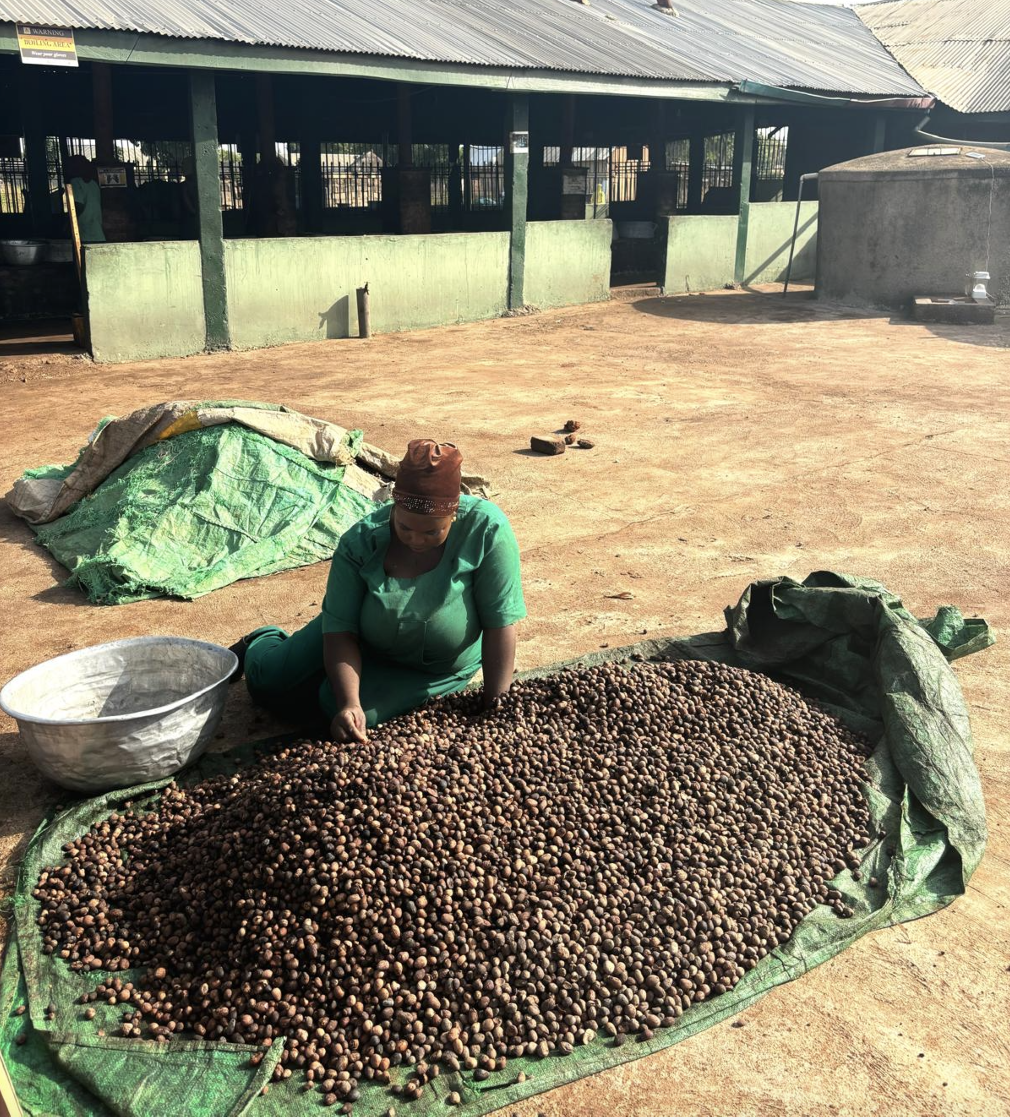
A woman sorting the kernels. (Picture: Zoe Geissler)
“We wash them before we sort because when they’re dirty, you cannot identify the good ones from the bad ones,” Mrs. Lacera notes. Despite the manual nature of this task, with experience, women can quickly distinguish high-quality kernels from the rest—ensuring that only the best are selected for butter production.
Step 3: Crushing and Roasting—Unlocking Shea’s Potential
Sorted kernels move on to be crushed—sometimes with traditional wooden mortars and pestles, but increasingly, with mechanical aids in modern cooperatives. After being crushed, these kernels are sun-dried, then roasted over open fires or in roasting machines. Roasting is a pivotal stage: experts say it typically lasts between 30 and 45 minutes per batch, but requires constant attention because overheating can harm both yield and oil quality. The aroma released at this stage is often described as earthy and distinctive, a familiar smell in many rural Nigerian communities.
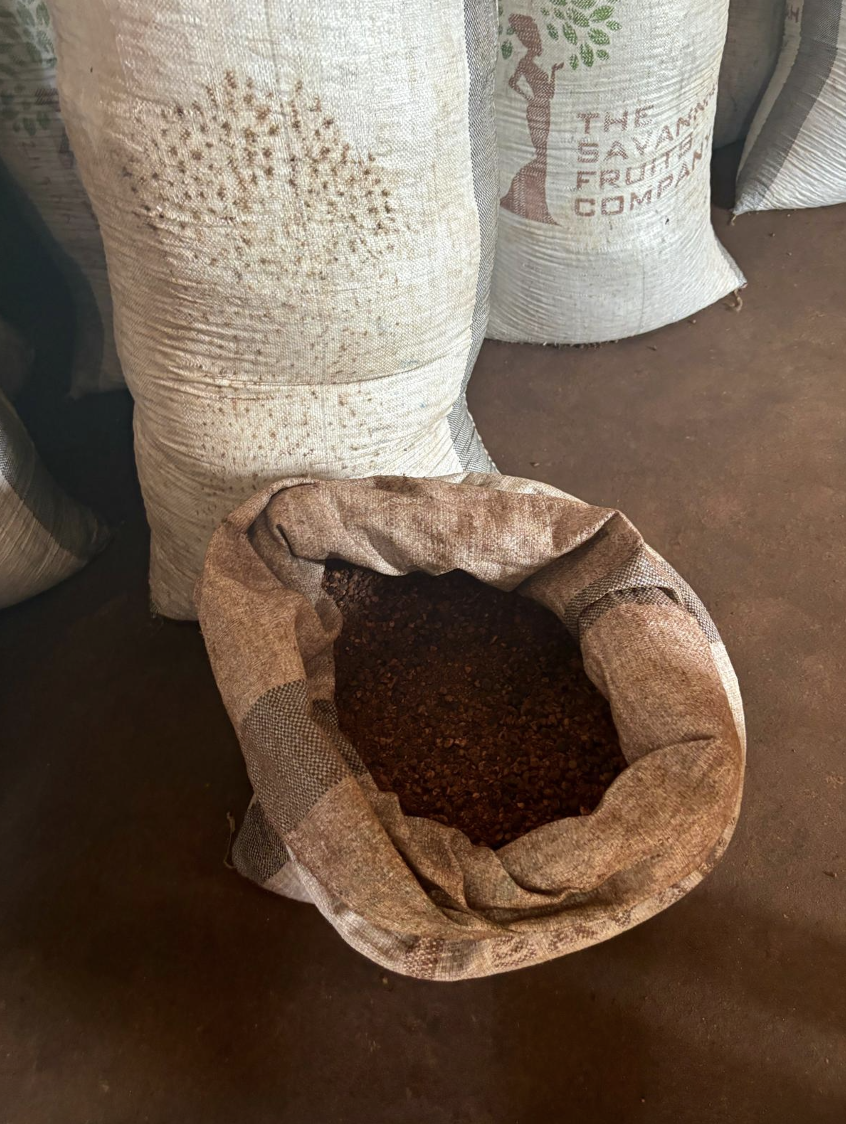
The crushed kernels, ready for roasting. (Picture: Zoe Geissler)
Step 4: Grinding and Kneading—The Heart of Transformation
With the roasted kernels ready, the next step is grinding—transforming them into a thick, oily paste not unlike melted chocolate. Traditionally, this was done with stones or primitive grinders, but in recent years, many cooperatives and businesses, including those in Nigeria and Ghana, have invested in small-scale mechanization for greater efficiency.
“Now that we use machines, we get more yield and can process more,” Mrs. Lacera says. “This means better profits and less physical strain for the workers.” This change, echoed by processing cooperatives in states like Kebbi, Zamfara, and Niger, marks a significant improvement in working conditions and productivity, allowing women to earn more while reducing manual fatigue.
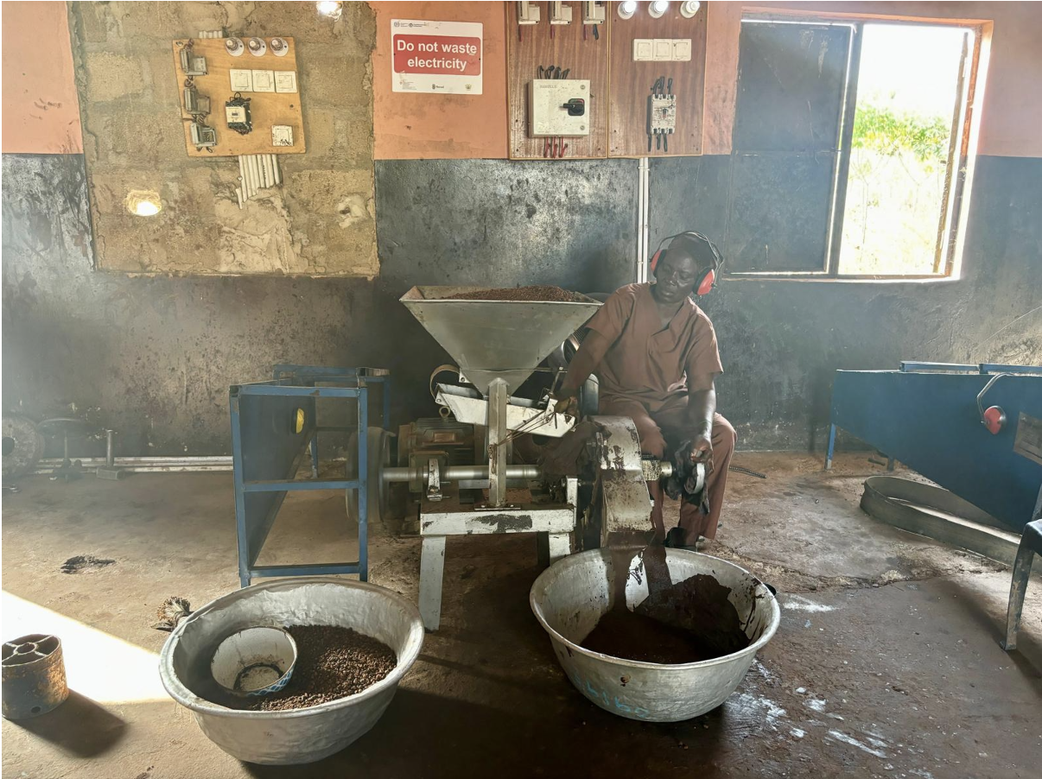
The crushed kernels, ready for roasting. (Picture: Zoe Geissler)
Step 5: Boiling, Filtering, and Packaging—Bringing Shea Butter to the World
Now comes one of the most intense stages—boiling. The shea paste is heated to very high temperatures, then filtered multiple times to remove impurities and clarify the butter. Women often perform this work with minimal protective clothing, braving intense heat and steam. Once the liquid cools and solidifies, the butter is ready to be packaged. Yumzaa and similar businesses typically offer a variety of packaging options, from household-sized tubs to industrial drums for export or further refining. According to Mrs. Lacera, “Our customers process it further into products such as chocolate, cosmetics, and cooking oils,” underscoring the versatility of shea as both a foodstuff and a beauty staple.
Beyond Beauty: Shea Butter’s Social and Economic Power
Shea butter is more than just a beauty ingredient—it’s deeply woven into the fabric of life for millions of women across the Sahel region. From rural communities near Jos, Nigeria, to villages around Tamale, Ghana, shea processing empowers women financially, allowing them to support their households, pay school fees, and invest in their futures. According to a 2022 report from the Global Shea Alliance, the industry supports up to 16 million women across West and Central Africa.
Yet, the shea industry faces ongoing challenges. Production is physically grueling, and often takes place under challenging conditions, with minimal mechanization or safety infrastructure. Periodic swings in global demand and fluctuating market prices can also leave smallholder producers vulnerable economically.
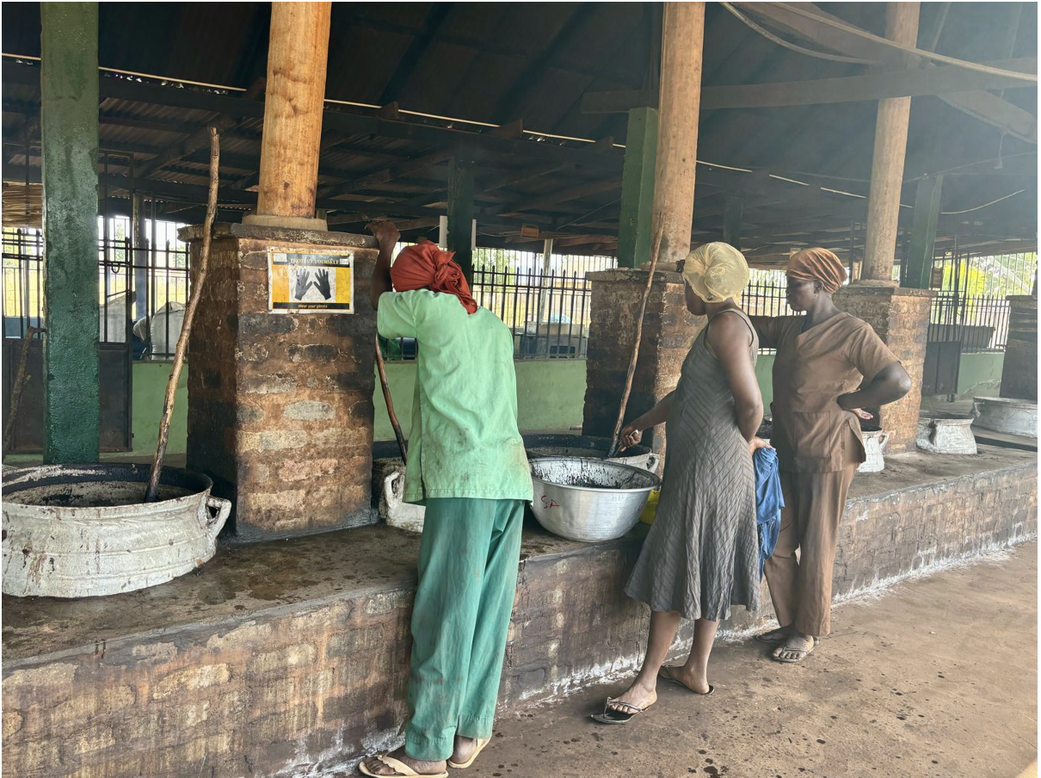
Boiling involves a lot of heat. (Picture: Zoe Geissler)
The Nigerian Context: Opportunities and Hurdles
Nigeria is Africa’s largest shea nut producer, accounting for more than half of the continent’s output, according to data from the Nigerian Export Promotion Council (NEPC). The country’s growing export market holds major promise, particularly for job creation and empowering rural women. Despite this, stakeholders continue to call for greater investment in mechanization, improved roads and market access, and more consistent trade policies. As Abuja-based agribusiness expert Halima Yusuf explained in a recent seminar, “If we invest more in post-harvest handling and local processing, Nigeria could lead not only in raw nut production but also in global exports of refined shea products.”
Competition is fierce, with Ghana, Burkina Faso, and Mali all vying for a share of the international market. Sustainability is another critical concern—experts warn that overharvesting, bush burning, and climate change threaten shea tree populations. Some NGOs and agronomists, including the Nigeria-based Shea Empowerment Foundation, work to train local producers on sustainable collection and tree care practices.
Many voices are calling for more recognition of shea’s value chain in Nigerian policymaking, including tax incentives or low-interest loans for women’s cooperatives, expanded processing centers, and nationwide campaigns to enhance product quality for both local and foreign buyers.
Connecting Africa and the World Through Shea
The global appetite for natural, sustainable cosmetics and food products is only increasing, putting West African shea at the center of a burgeoning export sector. Multinationals and local brands alike tout shea butter’s natural healing properties, and continued investment in local supply chains could boost rural economies long into the future.
However, as brands profit abroad, it’s vital to remember the women at the roots of the industry—from pickers in Kebbi, Nigeria, to processors in Tamale. Their sweat, tradition, and resilience are what make every export possible. The future of shea—both in Nigeria and across Africa—depends on continued investment, fair trade practices, and greater community support, ensuring these local heroes receive their due reward.
What do you think of the challenges and opportunities facing Nigeria’s shea industry? Should more be done to support women and enhance local value addition? Share your thoughts in the comments and let your voice be heard!
Have a business or community story that deserves the spotlight? Thinking about selling your inspiring journey or featuring your local shea cooperative? We’re eager to amplify grassroots voices and unsung success! Reach out to us at story@nowahalazone.com to get your story published or discuss story sales.
For general inquiries, business news tips, or to share your insights as an expert, contact us at support@nowahalazone.com.
Join the conversation—leave a comment below about the future of Nigeria’s shea industry, and follow us for more uniquely African business stories and updates!
Stay connected: Facebook | X (Twitter) | Instagram

